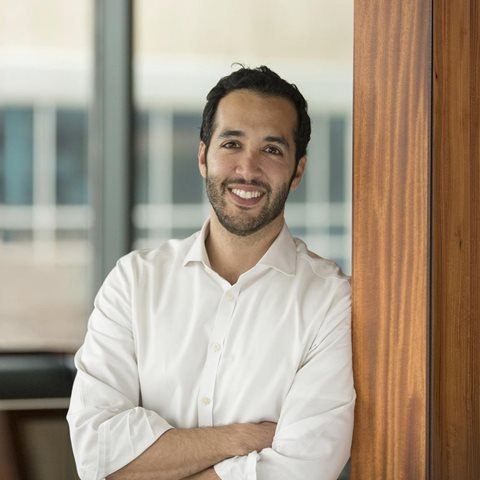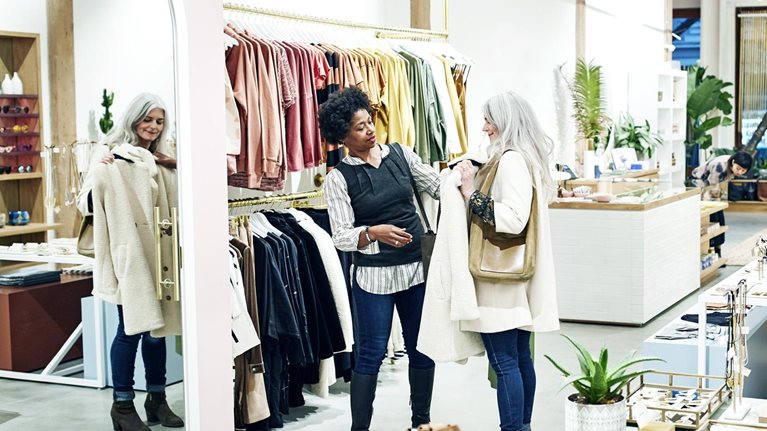The changeable nature of fashion extends well beyond its seasonal changes of what to wear. In recent years, one of the industry’s most dramatic changes involves New York City’s position as a global fashion capital.
Within the United States, New York City has one of the country’s highest concentrations of fashion sales, talent, and employment. Activities related to fashion—which we define as fashion retail, wholesale and distribution, along with textile, apparel, footwear and jewelry manufacturing—contributed more than $50 billion in direct sales, $45 billion in indirect sales, and more than 130,000 jobs in 2022.1
New York is also home to prominent design schools, including the Fashion Institute of Technology and New School Parson’s School of Design. Over 2,600 graduates in the city across all schools received fashion-specific degrees and certificates in 2022.2

State of Fashion 2025: The global fashion industry faces economic uncertainty, a dynamic market, and consumer behavior shifts. Finding pockets of growth means navigating a complex maze. Read the latest report here.
In addition, most big fashion brands have a presence in New York, given its prime position in commerce and tourism.3 The local ecosystem drives a virtuous circle that attracts and rewards not just brands but retailers, designers and shoppers, suppliers and producers, importers and distributors, the media, education, investors, real estate owners, trade shows and other events, and industry associations.
But although New York City has played a prominent role in shaping the global fashion industry, fashion companies there are now experiencing sharp declines in revenues, employment, and international reach. Maintaining New York’s prominence will require efforts throughout the region’s fashion ecosystem. In this article, we describe the crossroads at which New York’s fashion industry finds itself, and then we suggest actions for enabling it to maintain and expand its impressive legacy.
Powerful trends transforming the industry
New York City’s fashion industry has a rich heritage (see sidebar “What makes New York unique in the fashion world”). However, according to research conducted by McKinsey and the Partnership for New York City,4 the health of the industry in New York has fundamentally changed. Through interviews with industry leaders and reviews of economic data through 2023, fashion media, and third-party studies, we identified key indicators reflecting the New York fashion sector’s vulnerability.
Our research shows that the local industry’s inflation-adjusted gross regional product—the final market value of all fashion goods and services produced in New York City—started to decline in 2014. After a sharp drop of 19.6 percent from 2019 to 2020, the industry has yet to recover (Exhibit 1).5

Employment in the industry has been shrinking for a decade, but the COVID-19 pandemic hit local fashion industry workers especially hard (Exhibit 2).6 The industry now employs 50,000 fewer people than it did just ten years ago, with declines of 30 to 50 percent in apparel and textile manufacturing jobs.7 Overall fashion’s recovery has lagged that of other sectors, such as health services, education, and leisure and hospitality.8

Furthermore, the talent pipeline may be shrinking. Completions of New York fashion education fell by 30 percent in 2022 from a peak in 2016 (Exhibit 3).9 During the same time period, national college graduation figures grew.10

Retail remains a bright spot, but the landscape has changed. In the fourth quarter of 2023, the Manhattan retail availability rate (which encompasses 11 prime corridors, including Soho, Fifth Avenue, and Madison Avenue) was at 15 percent, the lowest rate in nine years, and asking rents continued their growth trend—up 5.4 percent year over year, the fifth consecutive quarterly increase.11 However, many multibrand specialty stores that cultivated and showcased emerging brands have shuttered; examples include Barneys New York, Henri Bendel, Opening Ceremony, and Lord & Taylor. Industry experts say the disappearance of such stores has made it more difficult for new designers to get traction with buyers and shoppers.
Other shifts involve manufacturing. Greater decentralization of production has reduced the amount of work taking place in and around New York City. The square mile of the Garment District in Midtown once hosted a complete ecosystem of manufacturers, designers, and suppliers. Today, most manufacturing has moved to far less expensive locations overseas, leaving New York with mostly prototyping and sample production.
New York Fashion Week (NYFW) also has undergone substantial changes in recent years. Key American brands have shifted their presentation to fashion weeks overseas to reach more international buyers and press, and they perceive reductions in citywide engagement. Recently, however, NYFW has shown signs of resurgence, including the return of designers such as Thom Browne.
Potential causes of historical trends
Five themes that emerged from our research and conversations with industry leaders may help explain the shifts in the fashion industry in New York:
- Rise of e-commerce. New York continues to be known as a destination for flagship retail stores, but the increasing adoption of e-commerce has created greater competition for brick-and-mortar retailers. To stay ahead in an increasingly digitized landscape, brands are rethinking their store footprints and focusing on experiential, community-building retail in smaller markets away from New York.
- Decentralization of influence. Technology, especially social media use, has shifted the landscape of fashion influencers. A new breed of tastemakers can be anyone and anywhere. Their impact diminishes the former outsize influence of New York City–based magazines and tastemakers.
- Industry consolidation. The fashion industry, especially in luxury, has undergone heavy consolidation, led by European conglomerates. About 98 percent of the economic growth in the luxury segment of public fashion companies is controlled by just four companies based in Europe: Hermès, LVMH, Kering, and Richemont.12 As a result, independent brands are finding it harder to compete.
- High costs of living and doing business. The costs of office space and retail space in New York are among the highest of fashion capitals in the United States and abroad, and they continue to rise. At the same time, the high cost of living could make it more difficult to attract and retain talent.13
- Lack of support to scale up. Building and scaling a successful fashion brand requires support from a network of investors, mentors, and retailers. Industry leaders tell us that designers and brands see New York as a more challenging place to find and secure this support, with few mentorship opportunities and more limited institutional funding than in decades past. And the reduction of retail venues raises concerns about where new designers can showcase their brands.
I don’t know who can make this happen, but it’s about funding. How do you get support when you’re at the next level? You’re known and established. You have the proven track record. Your clothes are selling. What’s next to help you grow?
Contemplating the future
There is considerable debate about what the future of New York City’s fashion ecosystem could or should become. Among the stakeholders we interviewed, opinions varied, but there is a consensus that the city is unlikely to revert to its past form.
Determining how to measure success requires input from a broader cross-section of stakeholders and a coalition leading the charge. Some potential factors, however, include the ease with which emerging designers launch successful brands (including the number and the survival rates of those brands and their ability to scale), the resilience of the workforce (including, for example, volume of fashion-related employment across parts of the value chain), and the demand for New York fashion (including the draw of notable fashion events in New York). New York does not need to lead across all dimensions, but it should lean into its unique value proposition and competitive edge—for example, its remarkable nexus to adjacent industries such as technology and finance, as well as its unrivaled diversity and culture—to reimagine new possibilities.
Whatever the path forward, several questions remain central: How can New York City continue to be a place where emerging designers thrive? How can it maintain its status as a nurturing ground for creative talent in fashion? How does it stay prominent in the global fashion industry?
How to support New York’s fashion ecosystem
In light of the preceding considerations, the efforts being made to bolster growth in retail and tourism, and the strides that have been made in advancing New York’s fashion industry, we can propose actions that might help bolster growth in the industry. Key measures could include activating talent, helping emerging brands to scale, building a capable workforce, and revitalizing industry demand.
Regardless of the measures taken, unlocking the full potential of New York’s fashion industry will require a sharp focus on execution and delivery. Leaders across the fashion value chain can continue working together to attract, develop, and retain talent, but success will hinge on concerted action, coordination, sustained awareness, and investments.
Reimagining retail to raise the bar on customer experience and drive profitable growth.
Supporting initial designer activation
New York is the most populous city in the nation and the home of top brands, retailers, and fashion schools. Therefore, the city is well positioned to attract and develop plenty of fashion talent. Still, it may be falling short from the beginning of a designer’s career.
Some services are particularly important to emerging designers. In a 2010 survey by the Pratt Center for Community Development that still seems relevant today, 86 percent of design student respondents said the most helpful service they found in the Garment District for their start-ups was “finding space,” followed closely by access to materials and funding.14
Activating more talent and providing them with the services and sense of community they need requires congregation and centrality. One approach is a central designer campus—a shared and easily accessible physical hub where emerging designers can work side by side. They can enjoy subsidized workspaces, pooled resources such as photographers and “fractional executives,” a materials library, programming, and mentorship from industry players. All these features could unlock logistical and creative advantages and overcome initial setup challenges.
A few enablers can help sustain design campuses. For example, a skilled operator could manage programming, recruitment, facilities, and industry connections. Success also requires a viable business model, such as ownership of the building to keep rents reasonable, and the engagement of industry leaders who can provide mentorship, connections, and credibility.
Helping emerging brands scale and commercialize
After overcoming initial activation challenges, talent needs support to scale. A lack of access to capital that continues beyond the first year remains an industry pain point; options are limited for established designers looking to reach the next milestones of their careers.
Our interviews also underscored the lack of accelerators devoted to design. An accelerator program could connect designers with mentors and investors across business life cycles. These mentors and investors may make fixed investments in return for equity and may connect with a wider network of other funders, retailers, buyers, and media who can help brands grow. Other accelerators in New York could help designers navigate a wide range of options suited to individual interests and aspirations.
The answer [to survivorship] is to create a campus for the younger designers and have them be supported by very talented retailers or even executives.
The long-term success of accelerators generally requires the participation of industry leaders with the know-how and expertise to support talent in different stages of their journeys, the involvement of financial institutions that can provide more traditional funding, and a rigorous approach to identifying emerging creative talent with true commercial potential.
Exposure to consumers also is vital for commercializing talent, particularly now that many retail destinations for discovery (for example, Barneys) have closed.15 A storefront in a prime high-traffic location could give a rotating mix of emerging designers opportunities to experiment with products, merchandising, and actual shoppers, as well as the chance to reach a wider audience. The space could provide subsidized short-term leases and operate as a “white box” where brands could set up in just a couple of days, in contrast to more time-consuming and capital-intensive setups.
To capture attention in today’s crowded marketplace, a storefront needs a team with a keen curatorial eye for design and merchandising, along with access to a strong pipeline of emerging brands, a dedicated sales and operational team, and compelling marketing and events to drive awareness and foot traffic. A prime location is another key to reaching style-savvy, high-income shoppers.
One example of such a storefront is 12 Piccadilly Arcade in London—described as a pop-up boutique offering emerging and indie brands in a prime shopping district between Mayfair and St James Place.16 It’s supported by a partnership of the Westminster City Council, Heart of London Business Alliance, and the landlord, GPE. The partnership provides brands with free pop-up space to raise their profiles and grow.17
Building a more capable and diverse workforce
In industries around the world, we see ecosystems flourishing where talent comes from diverse backgrounds and has broad knowledge and experience.
I think New York produces great design talent. But there’s still a gap in the business side of fashion.
Schools can play an important role in enriching the talent ecosystem. They can collaborate more closely with employers, for example, to ensure that education programming meets the industry’s current needs. In fashion, this could include helping students become fluent not just in design but also in merchandising, finance, supply chains, and marketing. Employers could play more active roles on campus through course sponsorships, guest speaking opportunities, and programs that help students get practical, on-the-job experience.
The industry also needs ongoing support for diversity, equity, and inclusion. Initiatives could include recruiting more candidates from underrepresented populations and offering financially viable internships and job opportunities, perhaps including grants and housing benefits to supplement salaries, since “volunteer” roles favor students from affluent backgrounds.
We have found that the most successful partnerships between schools and employers have operators with workforce development expertise to forge relationships and make sure everyone’s needs are being met.
Revitalizing industry demand for New York fashion
While it is important to support initiatives that attract and develop talent, equally pivotal is the need to sustain demand for New York fashion. For generations, the city has attracted international buyers and press who have outsize impacts on the success of brands. Now is the time to embrace the city’s diversity to reengage a global audience.
Fashion Week is industry focused, but it could be a broader catalyst for New York. No one is focused on making it a city multiplier.
New York Fashion Week, for example, could raise the industry’s visibility by celebrating all the city has to offer. It could extend programming to include a wider array of events. Fashion weeks in Paris and Copenhagen have featured executive roundtables on pressing topics such as climate change and sustainability, helping to expand interest and the breadth of attendees.
New York might also help the fashion industry connect with other local industries, especially hospitality, food, and entertainment. South by Southwest in Austin is one example of a successful cross-industry event, celebrating “the convergence of tech, film, music, education, and culture.”18 In 2024, it included movie and TV premieres; conferences on AI, climate change, fashion and beauty, and many other topics; and a competition where 45 tech companies pitched their ideas to industry experts, early adopters, and venture capital and angel investors.19 In New York City, this model could help catalyze many industries, including fashion.
The input of NYFW attendees and industry leaders suggests that hosting events in a single or just a few more accessible locations could create more concentrated gatherings. In addition to logistical benefits, this could increase organic connections and maximize networking opportunities, which buyers, journalists, and other industry figures say they want.
Outside of NYFW, New York City is pursuing many efforts to make its commercial districts more vibrant to nurture its already strong consumer economy, including tourism and retail foot traffic. The “New” New York Panel, for example, aims to transform business districts into places where people can live, work, play, and shop 24/7. Repurposing space and filling vacancies more quickly also could help move the needle on revitalizing NYC fashion.20
Common elements of long-term success
The industry and its allies could consider a breadth of interventions to bolster the city’s fashion ecosystem. But in our experience serving a range of industries around the world, we’ve found that most successful and sustainable interventions share some characteristics:
- Champions to help corral and convene. Effective interventions may benefit from champions capable of bringing together diverse stakeholders. In the case of fashion, a mechanism enabling communication, collaboration, and alignment across key stakeholders in the ecosystem—industry leaders and councils, local government, schools, real estate, and others—could facilitate success. A coordinated forum could help track the pulse of New York’s fashion sector, align on a vision and objectives, and activate existing and new citywide initiatives.
- Win–win value propositions among stakeholders. As curated storefronts help designers and brands demonstrate commercial viability, landlords and nearby businesses could benefit from fresh buzz and foot traffic. Accelerators could benefit emerging designers while giving corporate partners and investors early access to up-and-coming talent.
- Self-sustaining mechanisms. New strategies and programs could improve longevity without a constant need for external funding. These could include diverse revenue streams for various initiatives, strategic corporate partnerships, and robust alumni engagement that diminish the need to continuously seek new support or sponsors.
- Fit-for-purpose solutions. Tailoring solutions to the unique needs of the fashion industry is important. From a financing perspective, for example, venture capital might not align with fashion industry dynamics. More traditional financing partners might be more suitable—say, individual or strategic investors who are well versed in the fashion business and take a longer-term view.
- Engaged industry stakeholders. The active involvement of industry leaders—from established brands to strategic investors to retailers—could include investments, mentorship, or hiring emerging talent. Identifying and bridging gaps in industry partnerships may help foster a more interconnected and supportive ecosystem.
- The right operators. Selecting operators with the right capabilities, authority, and expertise for particular interventions could drive success. Some could be developing programs for a central designer campus or accelerator; others might provide real estate expertise for a storefront. In any case, operators who align with the unique demands of each initiative can help it succeed and endure.
A call to action
Without targeted interventions to support the fashion ecosystem, the New York fashion sector may become less relevant on the global stage. In that case, it also would contribute less to the city’s economy and its appeal to talent, consumers, and tastemakers worldwide.
Now more than ever, this critical moment requires a collaborative effort among private and public players in fashion and adjacent industries to revitalize the sector. Together, they can find new ways to support fashion talent with more resources, infrastructure, and connections to develop new brands. As a result, New York could retain and reinforce its leadership in what it has always represented—entrepreneurship, creativity, diversity, and innovation—while preserving its enduring legacy as the world’s fashion capital.






